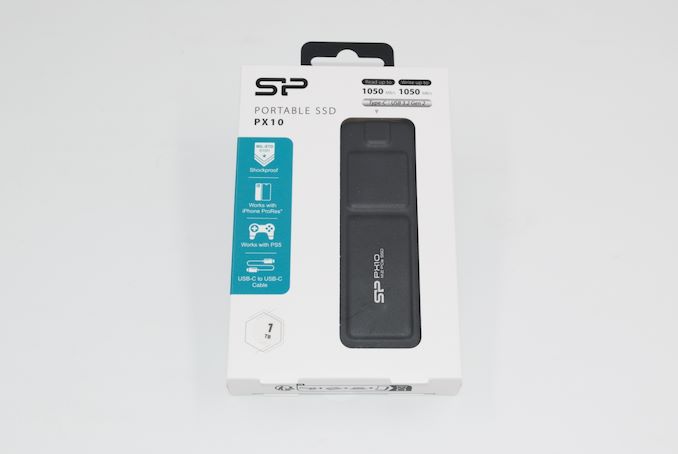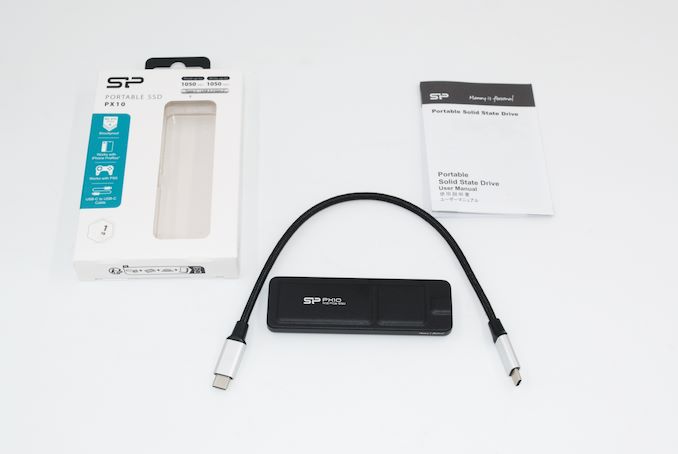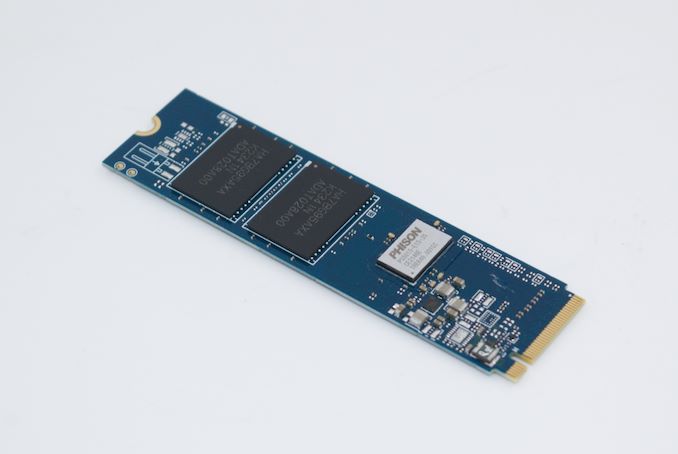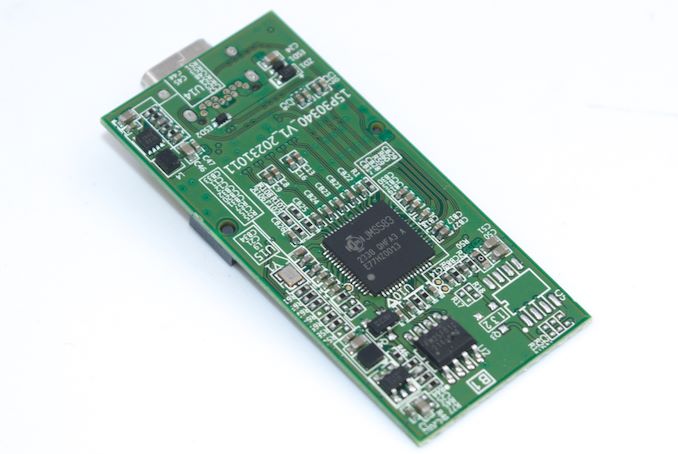Silicon Power PX10 Portable SSD Review: One Step Forward, Two Steps Back
by Ganesh T S on March 4, 2024 8:00 AM EST- Posted in
- Storage
- SSDs
- JMicron
- Silicon Power
- Portable SSDs

Silicon Power's product lines have made their mark in the entry-level market with aggressive pricing. In late 2023, the company introduced a number of portable flash-based storage devices - the MS70 / DS72 thumb drives with SSD-class performance (using the Phison U17 native UFD controller), and the PX10 portable SSD in a gumstick form-factor.
The PX10 targets power users and professionals with better performance consistency compared to the thumb drives, despite all of them belonging to the 1 GBps category. Silicon Power has adopted a traditional bridge-based design for this product, placing a M.2 2280 Gen 3 x4 NVMe SSD behind a USB 3.2 Gen 2 (10 Gbps) bridge chip.
This review takes a detailed look at the internals of the PX10, followed by a discussion of the results of putting it through our rigorous direct-attached storage performance evaluation routine. Prior to discussing the value proposition, we also look at the power consumption and thermal profile of the product.
Introduction and Product Impressions
Portable SSDs have experienced significant market growth, prompting silicon vendors like Phison and Silicon Motion to create single-chip native USB flash drive (UFD) controllers. Almost all of the recent product introductions in this category have incorporated them to offer compelling performance at very attractive price points (BOM savings due to lesser number of chips on the board) while also being power efficient.
In this market situation, Silicon Power's PX10 comes in as a bridge-based offering that is able to hit the price points of the single-chip PSSDs in the market. The form-factor of the PSSD reflects the underlying M.2 2280 NVMe SSD's gumstick nature. Silicon Power supplies a nylon-braided 30cm USB 3.2 Gen 2 Type-C to Type-C cable in the package.
The case is held together by plastic tabs (the top part of the PX10 is aluminum, while the bottom segment is polycarbonate). It can be pried open to reveal the internals.
The case has a stylish, yet solid feel to it, with the metal top and thin nature adding to its allure. Silicon Power claims that the PX10 has a MIL-STD 810H (Method 516.8) certification, indicating shock-proofing with an element of ruggedness.
Silicon Power equips the PX10 with its P34A60 M.2 2280 Gen 3 x4 NVMe SSD. This model was launched in late 2019 with a Silicon Motion SM2263XT controller and Intel's 64L 3D TLC. The company is now manufacturing these SSDs with Phison's E15T controller and (likely) SK hynix's V7 176L 3D TLC. Our PX10 review sample was with the Phison-based SSD.
The main board uses the JMicron JMS583 bridge chip. This was quite popular in the initial wave of NVMe SSD enclosures back in 2018, but ended up causing significant consumer grief with newer platforms from late 2019 onwards. JMicron ended up having to spin out new silicon revisions. The PX10 uses the latest and greatest A3 silicon (fourth revision), but this is still a 2018-generation product.
The PX10 supports S.M.A.R.T passthrough, as shown in the CrystalDiskInfo screenshot below.
| S.M.A.R.T Passthrough - CrystalDiskInfo | |
 |
|
The table below presents a comparative view of the specifications of the different direct-attached storage devices presented in this review.
| Comparative Direct-Attached Storage Devices Configuration | ||
| Aspect | ||
| Downstream Port | PCIe 3.0 x2 | PCIe 3.0 x2 |
| Upstream Port | USB 3.2 Gen 2 Type-C | USB 3.2 Gen 2 Type-C |
| Bridge Chip | JMicron JMS583 | ASMedia ASM2362 |
| Power | Bus Powered | Bus Powered |
| Use Case | Light-weight 1GBps-class portable SSD in a gumstick form-factor with focus on style and consistency | Light-weight 1GBps-class portable SSD with a security focus (fingerprint reader integrated) |
| Physical Dimensions | 103.4 mm x 33 mm x 10.3 mm | 85 mm x 57 mm x 8 mm |
| Weight | 33 grams | 58 grams |
| Cable | 30 cm USB 3.2 Gen 2 Type-C to Type-C | 30 cm USB 3.2 Gen 2 Type-C to Type-C 30 cm USB 3.2 Gen 2 Type-C to Type-A |
| S.M.A.R.T Passthrough | Yes | Yes |
| UASP Support | Yes | Yes |
| TRIM Passthrough | Yes | Yes |
| Hardware Encryption | No | Yes |
| Evaluated Storage | 4x 256GB HA7BG95AXA Packages (SK hynix V7 176L 3D TLC) | Samsung 92L V-NAND (5th Gen.) |
| Price | USD 90 | USD 160 |
| Review Link | Silicon Power PX10 1TB Review | Samsung Portable SSD T7 Touch 1TB Review |
Prior to looking at the benchmark numbers, power consumption, and thermal solution effectiveness, a description of the testbed setup and evaluation methodology is provided.
Testbed Setup and Evaluation Methodology
Direct-attached storage devices (including thumb drives) are evaluated using the Quartz Canyon NUC (essentially, the Xeon / ECC version of the Ghost Canyon NUC) configured with 2x 16GB DDR4-2667 ECC SODIMMs and a PCIe 3.0 x4 NVMe SSD - the IM2P33E8 1TB from ADATA.
The most attractive aspect of the Quartz Canyon NUC is the presence of two PCIe slots (electrically, x16 and x4) for add-in cards. In the absence of a discrete GPU - for which there is no need in a DAS testbed - both slots are available. In fact, we also added a spare SanDisk Extreme PRO M.2 NVMe SSD to the CPU direct-attached M.2 22110 slot in the baseboard in order to avoid DMI bottlenecks when evaluating Thunderbolt 3 devices. This still allows for two add-in cards operating at x8 (x16 electrical) and x4 (x4 electrical). Since the Quartz Canyon NUC doesn't have a native USB 3.2 Gen 2x2 port, Silverstone's SST-ECU06 add-in card was installed in the x4 slot. All non-Thunderbolt devices are tested using the Type-C port enabled by the SST-ECU06.
The specifications of the testbed are summarized in the table below:
| The 2021 AnandTech DAS Testbed Configuration | |
| System | Intel Quartz Canyon NUC9vXQNX |
| CPU | Intel Xeon E-2286M |
| Memory | ADATA Industrial AD4B3200716G22 32 GB (2x 16GB) DDR4-3200 ECC @ 22-22-22-52 |
| OS Drive | ADATA Industrial IM2P33E8 NVMe 1TB |
| Secondary Drive | SanDisk Extreme PRO M.2 NVMe 3D SSD 1TB |
| Add-on Card | SilverStone Tek SST-ECU06 USB 3.2 Gen 2x2 Type-C Host |
| OS | Windows 10 Enterprise x64 (21H1) |
| Thanks to ADATA, Intel, and SilverStone Tek for the build components | |
The testbed hardware is only one segment of the evaluation. Over the last few years, the typical direct-attached storage workloads for memory cards have also evolved. High bit-rate 4K videos at 60fps have become quite common, and 8K videos are starting to make an appearance. Game install sizes have also grown steadily even in portable game consoles, thanks to high resolution textures and artwork. Keeping these in mind, our evaluation scheme for portable SSDs and UFDs involves multiple workloads which are described in detail in the corresponding sections.
- Synthetic workloads using CrystalDiskMark and ATTO
- Real-world access traces using PCMark 10's storage benchmark
- Custom robocopy workloads reflective of typical DAS usage
- Sequential write stress test
In the next section, we have an overview of the performance of the Silicon Power PX10 in these benchmarks. Prior to providing concluding remarks, we have some observations on the PSSD's power consumption numbers and thermal solution also.


















4 Comments
View All Comments
meacupla - Monday, March 4, 2024 - link
Those thermal pads are so small. They can absorb more heat with a larger patch and don't cost that much more when bought in bulk.Although, seeing as they used those outdated JMicron bridge chips, it's pretty clear they are cutting every corner possible. I'm surprised they could acquire any at all.
Eliadbu - Monday, March 4, 2024 - link
Would you test SSD enclosures? There are many solution in the market with speeds of 10,20 and 40Gbps, decoupling the interface and storage can bring several benefits to the user.dwillmore - Monday, March 4, 2024 - link
So this is a DRAMless drive with no access to a HMB? That's got to effect performance and longevity. Then again, this is an external drive and won't see the level of use (wear) that an internal drive will see, so maybe it isn't an issue. It still seems to be a poor design decision.meacupla - Monday, March 4, 2024 - link
The SSD inside is an A60 and is an ultra budget Gen3 drive that only does 2200MB/s / 1800MB/s.It will do HMB if you stuff it into a PC.
The JMicron bridge chip is limited to 10Gbps=1050MB/s anyways, so who cares.
My money is on the bridge chip cooking itself before the SSD fails.